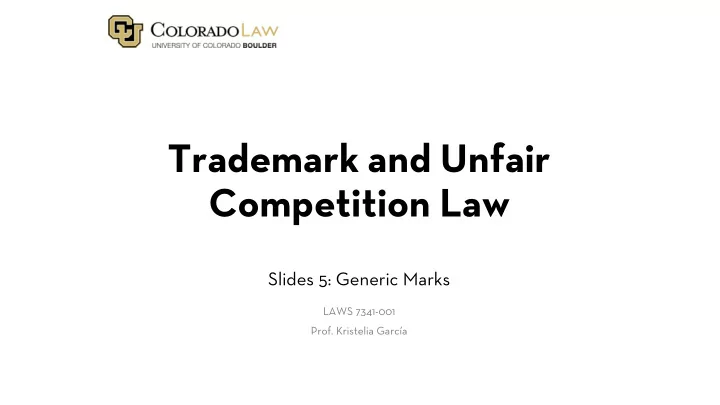

Trademark and Unfair Competition Law Slides 5: Generic Marks LAWS 7341-001 Prof. Kristelia García
Class Outline • Generic Terms • Genericide • Genus determinations • Surveys for genericism: • Teflon • Thermos 2
Types of Generic Marks: 1. Initial finding of genericness (e.g., “Multistate Bar Examination” for legal testing); or 2. Genericide; i.e., through loss of distinctiveness (e.g., aspirin) 3
Standard Use Trademark Registration Procedure (1) File application (“use” or “1(a)”) with PTO (2) Application assigned to examiner to determine whether proper; examiner to communicate any problems to registrant (who has 6 months to cure) (3) Examiner makes final determination (denials appealable to Trademark Trials and Appeals Board (TTAB); and next to Federal Circuit) (4) Approvals are published in the Gazette, and objectors have 30 days to file. If no objection, registration issues (good for 10 years, renewable indefinitely so long as in use) 4
“Intent to Use” (ITU) Trademark Registration Procedure (1) File “Intent to Use” application (2) Application reviewed by examiner and, if found eligible, published for opposition (30-day period allowed for opposition filings) (3) If no opposition, PTO issues “notice of allowance” (4) Applicant has 6 months from issuance of “notice of allowance” to commence use and file a “Statement of Use” (one extension allowed, for cause, up to a total of 36 months) (5) Upon examination and approval of that “Statement of Use,” registration issues (6) **Once issued, priority of use back dates to date of initial “Intent to Use” application 5
Composite Marks Marks Involving Two or More Elements (e.g., two words, or a word and a graphic design) Do the elements retain their original meanings, or do they create a new meaning when joined together? New Original meaning meanings Composite Mark “Unitary Mark” e.g. e.g. SCREEN WIPES BLACK MAGIC (may require (registrable without disclaimer) disclaimer) 6
Composite Marks Both elements Both unregistrable? One element registrable? registrable and the Registration denied Registration granted other not? e.g. e.g. e.g. FIDELITY SCREEN WIPES ALTA VISTA INVESTMENTS for antistatic for for money cleaning cloths for web search services; management computer RED BULL for services Screens energy drink PRESTO (nothing to disclaim; (these unitary BURGER competitor need) marks are for cooking arbitrary & utensils fanciful in 7 context)
Composite Marks Composite Marks where one element registrable and the Separate words: other is not Disclaimer of non- registrable word required Words joined or creatively connected: FIDELITY potentially no INVESTMENTS disclaimer required for money management services MEANMACHINE for lawn mowing machine PRESTO RAIN-X BURGER for waterproofing chemical for cooking utensils 8
The “primary significance” test for genericness: à Is the “primary significance”of the mark intended to identify the product, or the producer? 1. What is the genus of the goods at issue? 2. Does the relevant public understand the designation primarily to refer to that genus of goods? May be more complicated if there is more than one common name (e.g., soda, pop, coke, soft drink) 9
10
More Genericide Victims • Zipper • Escalator • Cellophane • Thermos • Aspirin • Trampoline • Kerosene • Granola • Brassiere • Heroin (*a “suggestive” mark said to make the user feel “hero-ish,” according to its creators at Bayer) 11
12
Avoiding Genericide 1. Use a compound name (i.e. a generic term *following the brand name): e.g. Instead of “Zipper,” use “Zipper slide fastener” or Instead of “Viagra,” use “Viagra sildenafil citrate” on all marketing materials 2. Use the word “brand”: e.g. “Zipper brand slide fasteners” Companies sometimes use the “TM” mark to make the same point, e.g. “Zipper™” 3. Use the mark on multiple products (a “family” of products): e.g. JELL-O brand gelatin & JELL-O brand pudding pops 4. Police the market: e.g. send threatening letters; run ads 13
14
15
16
The “genus” test Canfield v. Honickman : “When a producer introduces a product that differs from an established product class in a significant, functional characteristic, and uses the common descriptive term of that characteristic as its name, that new product becomes its own genus, and the term denoting the genus becomes generic if there is no commonly used alternative that effectively communicates the same functional information.” 17
Applying the “genus” test: à Established product class: razor blades à New product that differs in a particular characteristic: razor blades that dispense lotion as you use them à New name: self-lubricating razor à Therefore “self-lubricating razors” are a new genus (not a species) à Whether “self-lubricating razor” is generic for that new genus depends on competitors’ need – is there any other way for them to convey the function or characteristic in this case, lotion dispensation? 18
Surveys for Genericism 1. Thermos 2. Teflon (generally reserved for genericide cases) 19
Recommend
More recommend